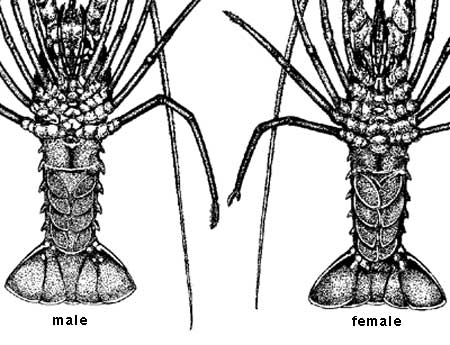To tell if a lobster is male or female, examine the first set of swimmerets. Males have larger, harder swimmerets, while females have smaller, softer ones.
Lobsters are fascinating creatures with distinct features that differentiate males from females. Identifying their gender is crucial for both fishing regulations and culinary purposes. Males typically have larger claws and a narrower tail, while females possess a broader tail to carry eggs.
Observing the swimmerets, located on the underside, provides a clear indication of the lobster’s sex. This knowledge ensures sustainable fishing practices and helps in preserving the lobster population. Whether you are a seafood enthusiast or a marine biologist, understanding these differences enhances your appreciation of these incredible crustaceans.
Differences Between Male And Female Lobsters
Male lobsters have larger claws. Female lobsters have a wider tail. The male’s first pair of swimmerets are hard. Female swimmerets are soft and feathery. The female’s tail is also rounder.
Female lobsters often carry eggs. Males tend to be more aggressive. Females are usually more passive. Male lobsters compete for territory. Females focus on nesting and egg care.

Credit: shop.legalseafoods.com
Examining The Tail
The tail of a lobster can reveal its gender. A male lobster has a narrower tail. In contrast, a female lobster has a wider tail. This is to carry eggs.
Male lobsters have a V-shaped notch at the base of their tails. Female lobsters have a wider, more rounded tail.
Male lobsters are often larger in overall size. Female lobsters carry eggs on their tails. Look for small, black dots under the tail.
Another way to tell is by examining the first pair of swimmerets. Males have hard, bony swimmerets. Females have soft, feathery ones.
Checking The Swimmerets
Checking the swimmerets can reveal a lobster’s gender. Males have hard, bony swimmerets, while females have soft, feathery ones. This simple observation helps distinguish between male and female lobsters.
Location And Function
Swimmerets are small appendages on the underside of the lobster’s tail. These help the lobster swim and carry eggs. Males have larger and harder swimmerets. Females have softer and more flexible swimmerets.
Visual Identification
Look at the first pair of swimmerets. In males, they are larger and more rigid. In females, they are smaller and softer. Female lobsters also have wider tails to carry eggs.
Credit: www.cheftalk.com
Claw Size And Shape
Lobster claws provide clues to their gender. Males typically have larger, bulkier claws, while females sport smaller, more slender ones. Observing these differences helps identify lobster sex.
Male Claw Traits
Male lobsters have larger claws. These claws are bulkier and thicker. The crusher claw is usually bigger. It helps them fight and catch prey.
Female Claw Traits
Female lobsters have smaller claws. These claws are slimmer and more delicate. They use these claws to carry eggs. The smaller claws make it easier to protect their young.
Breeding Season Indicators
Male lobsters often show aggressive behavior. They fight other males to impress females. Female lobsters release pheromones to attract males. They may also molts during mating season. This makes it easier for males to mate with them.
Female lobsters carry eggs under their tails. These eggs are called roe. They attach to the swimmerets, which are small appendages. The eggs are bright orange when freshly laid. As they develop, the eggs turn dark. Males do not carry eggs. This is a clear sign to identify females.

Credit: dlnr.hawaii.gov
Expert Tools And Methods
A magnifying glass helps in seeing small details. You can spot tiny differences in lobsters. Look at the first pair of swimmerets. Male lobsters have hard swimmerets. Female lobsters have soft swimmerets. This tool makes it easier to see these parts clearly.
Experts use a few tricks. Check the tail shape. Males have thinner tails. Females have broader tails. Look at the underside of the tail. Females have a row of bristles. These bristles hold eggs. This is a quick way to tell their sex.
Common Myths Debunked
Many people think all lobsters have the same body shape. This is not true. Some say male lobsters have bigger claws. This is also a myth. Female lobsters can have big claws too. Another myth is that only male lobsters fight. Both genders can be aggressive.
Male lobsters have longer and thicker swimmerets. These are small legs under their tail. Female lobsters have wider tails to carry eggs. The first pair of swimmerets on males are hard. On females, they are soft. These differences help tell them apart.
Frequently Asked Questions
How Can You Identify A Male Lobster?
Male lobsters have larger claws and narrower tails. They also have hard, pointed swimmerets under their tails.
What Are The Features Of A Female Lobster?
Female lobsters have wider tails and softer, feathery swimmerets. These adaptations help them carry and protect eggs.
Do Male And Female Lobsters Taste Different?
No, both male and female lobsters taste the same. The gender does not affect the meat’s flavor or texture.
Why Is Tail Shape Important For Gender Identification?
The shape of the tail helps distinguish genders. Females have broader tails to carry eggs, while males have narrower tails.
Can Both Male And Female Lobsters Be Eaten?
Yes, both genders are equally edible. There is no culinary difference between male and female lobsters.
What Are Swimmerets In Lobsters?
Swimmerets are small, leg-like appendages under a lobster’s tail. They help in swimming and, in females, carrying eggs.
Conclusion
Determining a lobster’s gender is simple with these tips. Check for swimmerets and the shape of the first pair. Males have hard, pointed swimmerets; females have soft, feathery ones. Use these methods for accurate identification. Understanding the difference helps in cooking and conservation.
Happy lobster hunting!

